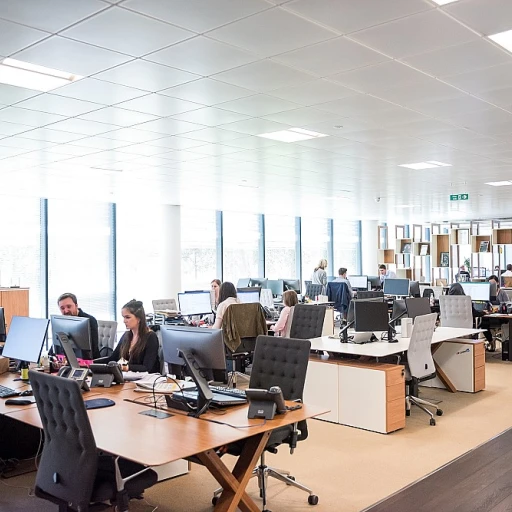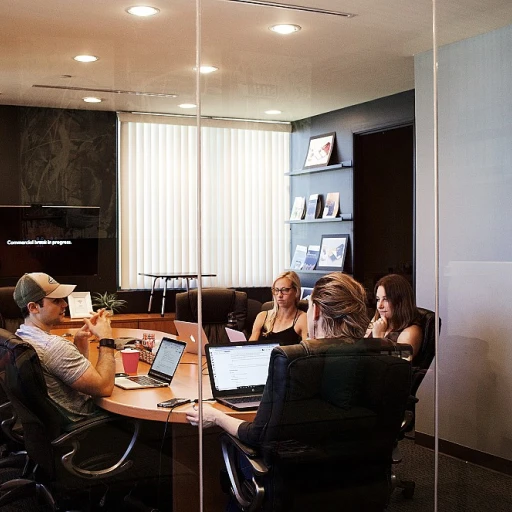Understanding the Importance of Logging Off
The Critical Role of Logging Off
In the modern workplace, effective office space management is essential for maximizing productivity and reducing costs. One sometimes overlooked aspect is ensuring employees take the necessary time to log off. Logging off is not just a technical detail; it is a fundamental part of work-life balance and operational efficiency. Returning to an office or even working remotely, employees whose schedules allow them to step away from their workspaces periodically often show increased job satisfaction, focus, and creativity. By encouraging this practice, businesses can create a healthier workplace environment. The rise of hybrid work models has further highlighted the importance of this practice. Employees working from home or dividing their time between home and office need to clearly differentiate work hours from personal time to prevent burnout. Notably, a clean desk policy can support this by ensuring that employees close their computers and clear their workspaces at the end of their workday. For Indian companies, which frequently face the challenge of high utility costs and maintaining expensive office spaces, logging off can directly translate into cost savings. Lights, computers, and other technologies can be turned off or reduced in usage, which reduces the overall utility expenses, making a significant difference in the budgets dedicated to office space maintenance. Yet, implementing an effective logging-off protocol can be complicated. Companies must navigate employee habits, potential resistance to change, and the technical specifics of monitoring and enforcing the policy. However, with thoughtful strategies and the right technological solutions, businesses can overcome these barriers to enjoy the benefits of reduced real estate costs and enhanced employee satisfaction.Challenges Faced by Indian Companies
Overcoming Office Space Challenges in Indian Companies
In India, maximizing efficiency in office spaces involves overcoming multiple challenges, especially in businesses that are managing both in-office and remote work dynamics. Whether dealing with full-time return to office or adopting hybrid work frameworks, companies often face obstacles that need strategic navigation. One of the main hurdles is the inefficiency in space management, which can lead to increased real estate and utility costs. Without a clear strategy for managing office spaces, businesses may find themselves stuck with excess workspace, contributing to unnecessary expenses. The clean desk policy and flexible workplace strategy are often adopted to counteract this, helping save money by minimizing underutilized areas. Another pressing issue is maintaining work-life balance, particularly for employees who are working remotely. The demand for a hybrid work environment has grown, with employees seeking a balance between remote working and in-person collaboration. Companies must invest time and resources into structuring effective workspace solutions that accommodate both preferences without compromising productivity and employee satisfaction. Furthermore, the rapid transition to remote work and hybrid models poses challenges in communication and collaboration. Effective management of these new forms of work requires commitment to technology and clear guidelines on how, when, and where employees can efficiently fulfill their roles. By addressing these key challenges, Indian companies can better align their business operations with modern demands, resulting in substantial cost savings and a more engaged workforce. Implementing these strategies will undoubtedly require a shift in management practices but promises a significant return on investment in terms of performance and cost efficiency.Strategies for Effective Logging Off
Implementing Effective Strategies for Logging Off
In the dynamic landscape of Indian companies, the ability to maximize efficiency by effectively logging off is increasingly becoming a priority. The shift towards hybrid work models and remote working has made it imperative for businesses to develop robust strategies that ensure both employee satisfaction and cost savings.
To begin with, companies need to foster a workplace culture that values work-life balance. Encouraging employees to log off at the end of their work hours not only boosts their morale but also enhances productivity when they return to their desks. This practice is crucial for maintaining a healthy work environment, especially in hybrid work settings where the lines between work and personal life often blur.
Businesses should also consider the potential of downsizing office spaces. By optimizing the use of real estate, companies can save significant amounts on utility costs and other overheads. This approach not only reduces costs but also aligns with future work trends that favor flexible and remote working arrangements.
Another effective strategy is the implementation of a clean desk policy. This not only ensures a clutter-free workspace but also encourages employees to log off and physically leave their desks, reinforcing the boundary between work and personal time. It is an essential component of space management that supports a more organized and efficient office environment.
Moreover, clear communication from management about the importance of logging off is vital. Regular reminders and structured guidelines can help employees understand the benefits of disconnecting from work, ultimately leading to better time management and reduced stress levels.
By adopting these strategies, Indian companies can create a more sustainable and efficient workplace. The emphasis on logging off not only contributes to cost savings but also enhances employee satisfaction, paving the way for a more balanced and productive work life.
Technological Solutions for Monitoring
Embracing Technological Enhancements for Monitoring Efficiency
Investing in technology can effectively aid companies in maximizing efficiency by ensuring productive office spaces and saving costs. Monitoring the use of office and remote work environments plays a critical role in achieving the desired balance in workplace strategies. Companies can benefit from implementing the following technological solutions:- Workspace Analytics Tools: These tools provide essential data on office usage, helping to manage dynamics within the office and optimize hybrid work arrangements. By analyzing patterns, managers can devise strategies to downsize office spaces where needed, enhancing cost savings.
- Smart Desks and IoT Devices: Internet of Things (IoT) devices, such as smart desks, allow real-time tracking of desk usage and employee presence, supporting clean desk policies. These tools can be instrumental in space management, crafting a more flexible work environment that enhances real estate efficiency and saves money in utility costs.
- Remote Work Monitoring Software: These applications enable businesses to assess remote working activities and employee outputs. Companies can uphold accountability and productivity standards even when employees are working remotely, contributing to overall employee satisfaction and work-life balance.
- Automated Systems for Logging Off: Automated log-off systems ensure that all inactive office equipment is switched off at the end of the day, reducing unnecessary utility costs. These solutions ensure cost savings and encourage employees to maintain a healthy work-life balance.
Case Studies of Successful Implementations
Real-World Success Stories in Office Space Management
As Indian companies navigate the complexities of modern work environments, several have successfully implemented strategies to enhance efficiency by optimizing office spaces. These case studies highlight the potential benefits and challenges of embracing a more flexible approach to workspace management.
One notable example involves a major IT company that transitioned to a hybrid work model. By allowing employees to work remotely part of the week, they managed to downsize their office space significantly. This shift not only resulted in substantial cost savings on real estate and utility costs but also improved employee satisfaction by offering better work-life balance. The company reported a decrease in overhead expenses, which in turn allowed them to invest more in employee development and technology.
Another case is a financial services firm that adopted a clean desk policy to promote efficient use of office spaces. This strategy encouraged employees to log off and clear their desks at the end of each day, fostering a more organized and productive work environment. The initiative also included technological solutions for monitoring desk usage, ensuring that office spaces were used effectively and reducing unnecessary costs.
Furthermore, a multinational corporation in the manufacturing sector implemented a workspace management system to optimize their office layout. By analyzing data on desk usage and employee preferences, they were able to redesign their office spaces to better support both full-time and remote working staff. This approach not only enhanced the workplace strategy but also contributed to improved employee engagement and productivity.
These examples underscore the importance of strategic office space management in the modern business landscape. By adopting innovative approaches and leveraging technology, companies can achieve significant cost savings while fostering a more dynamic and adaptable work environment. As the future of work continues to evolve, these strategies will be crucial for maintaining competitive advantage and ensuring long-term success.
Future Trends in Office Space Management
Emerging Trends in Office Space Management
The landscape of office space management is rapidly evolving, driven by the shift towards hybrid work models and the increasing emphasis on employee satisfaction and cost efficiency. As companies navigate these changes, several trends are emerging that could shape the future of workspaces.
One significant trend is the downsizing of traditional office spaces. With more employees working remotely, businesses are re-evaluating their real estate needs. This shift not only helps save money on utility costs but also allows for more flexible workspace designs that cater to hybrid work arrangements. Companies are finding that a smaller, well-managed office space can enhance productivity and employee satisfaction.
Another trend is the integration of advanced technological solutions to monitor and optimize office space usage. As discussed earlier, leveraging technology can streamline space management, ensuring that desks and meeting rooms are used efficiently. This approach not only reduces costs but also supports a clean desk policy, which is essential for maintaining a professional and organized work environment.
Moreover, the concept of flexible workspaces is gaining traction. Businesses are increasingly adopting strategies that allow employees to choose when and where they work. This flexibility is crucial for maintaining work-life balance and can lead to higher employee satisfaction. By offering a mix of remote work and in-office time, companies can attract and retain top talent while reducing overhead costs.
Finally, there's a growing focus on sustainable office practices. As companies look to the future, sustainability is becoming a key component of their workplace strategy. This includes energy-efficient buildings, eco-friendly office supplies, and policies that promote remote working to reduce the carbon footprint.
In conclusion, the future of office space management will likely be characterized by flexibility, technology, and sustainability. By embracing these trends, companies can not only save costs but also create a more dynamic and satisfying work environment for their employees.













